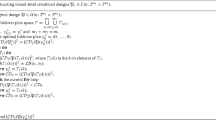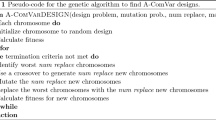Abstract
The results of a computer search for saturated designs for 2n factorial experiments with n runs is reported, (where n = 2 mod 4). A complete search of the design space is avoided by focussing on designs constructed from cyclic generators. A method of searching quickly for the best generators is given. The resulting designs are as good as, and sometimes better than, designs obtained via search algorithms reported in the literature. The addition of a further factor having three levels is also considered. Here, too, a complete search is avoided by restricting attention to the most efficient part of the design space under p-efficiency.
Similar content being viewed by others
Explore related subjects
Discover the latest articles, news and stories from top researchers in related subjects.References
Crosier, R. B. (1995) Some new saturated two-level designs. ERDEC Technical Report 225, Edgewood Research Devel-opment and Engineering Center, MO.
Dean, A. M. and Draper, N. R. (1996) Saturated main-effect designs for factorial experiments. Technical Report 580, pmDepartment of Statistics, The Ohio State University, June.
Ehlich, H. (1964) Determinantenabschatzzungen fur binare mat-rizen. Math. Zeitschr., 83, 123–132.
Grove, D. M. and Davis, T. P. (1991) Taguchi's idle column method. Technometrics, 33, 349–353.
Lin, D. K. J. (1993) Another look at first order saturated designs. The p-effcient designs. Technometrics, 35, 284–292.
Nguyen, N-K. (1996) An algorithmic approach to constructing supersaturated designs. Technometrics, 38, 69–73.
Plackett, R. L. and Burman, J. P. (1946) The design of optimum multifactorial experiments. Biometrika, 33, 305–325.
Wang, J. C. and Wu, C. F. J. (1992) Nearly orthogonal arrays with mixed levels and small runs. Technometrics, 34, 409–422.
Rights and permissions
About this article
Cite this article
Dean, A.M., Draper, N.R. Saturated main-effect designs for factorial experiments. Statistics and Computing 9, 179–185 (1999). https://doi.org/10.1023/A:1008961712217
Issue Date:
DOI: https://doi.org/10.1023/A:1008961712217




